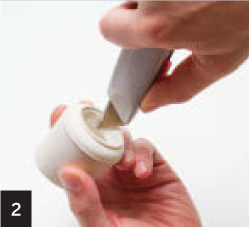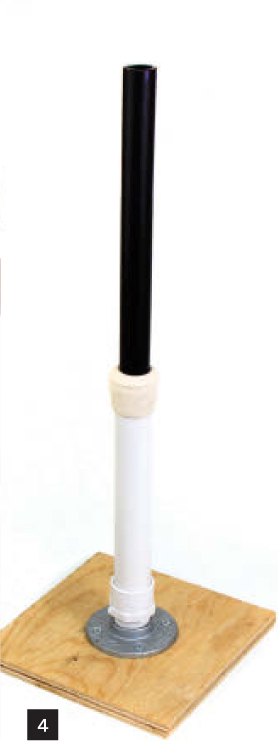PROJECTS DIY BASEBALL TEES
DIY Baseball Tees
Build a pair of adjustable, durable batting tees for half the price of store-bought.
![]() TIME: 1 HOUR
TIME: 1 HOUR ![]() COST: $40
COST: $40

Brad Huffman
![]() Baseball season is here, and my son William has moved up from tee-ball to coach-pitch league. Even though he won’t be using the batting tee in games anymore, it’s still a great tool to use in hitting practice. When our old tee wore out, I decided to see if I could put together a great tee for less than I could buy one. The answer: Yes!
Baseball season is here, and my son William has moved up from tee-ball to coach-pitch league. Even though he won’t be using the batting tee in games anymore, it’s still a great tool to use in hitting practice. When our old tee wore out, I decided to see if I could put together a great tee for less than I could buy one. The answer: Yes!
1. MAKE THE BASE
Center the floor flange on the plywood square and fasten it with wood screws.

2. MAKE THE STEM
Cut the PVC pipe to 13" long. Using a utility razor knife or a drill with a Forstner bit, cut a 11/8" hole in the end of the rubber furniture leg tip. Work slowly; it’s thick stuff. You’re looking for a snug friction fit with the 1¼" disposer hose, so be conservative. On the leg tips I bought, there are concentric ridges; one of them fell just within my 11/8" circle, so I used it as my cutting guide.

Now cram the PVC pipe into the furniture leg tip. This might be the hardest part of the build — it doesn’t want to fit, you’re really stretching and forcing it. Once you get it started, you can flip it over, put the leg tip on the floor, and press the pipe the rest of the way in.
Push the other end of the pipe into the male threaded adapter. You can use PVC cement if you want, but a strong friction fit should do the trick.
3. MAKE THE TELESCOPING BALL REST
Cut the 1¼" disposer hose to 2' long and stuff it into the hole you made in the chair leg tip. You want a tight fit, so when you adjust the height it stays put without slipping down. If necessary, widen the hole slightly to achieve the right fit.

Use the razor knife to carefully shave a bevel on the inside edge of the hose, so that it will cup the baseball and keep it more stable.
4. ASSEMBLE
Screw the stem’s threaded adapter into the flange on the plywood base. You can unscrew it for easy packing and transport.

Gunther Kirsch
TIP: Make your tee even more stable by slipping your batting weights (donuts, etc.) over the top to rest on the base.
Conclusion
This project specifies materials for making 2 tees, because I like to do double-tee batting drills that help improve my players’ swing technique.
Version 1 of this tee had a 24"-long PVC pipe. I hit off it for a while, and it proved to be relatively stable. As for durability, I was asked whether the PVC needed to be shorter to avoid being broken by an errant bat, so I tested it out. A good whack shattered the top of the tee. The “repair” was pretty easy. I sawed off the broken end and discovered that Version 2 worked just as well with a 13"-long pipe, with less chance of it being struck. It’s probably more stable too, due to the lower center of gravity. That’s the nice thing about a DIY project — if you do break the PVC pipe, you can easily replace it at negligible cost instead of buying a new tee.
I used V1 and V2 for almost all my hitting sessions last baseball season and for several games, and V2 seems plenty durable with the shortened PVC. The disposer hose has plenty of give so the tee doesn’t tip over every time you knock it. ![]()
Brad Huffman is a software developer by trade, with a genetic “I can make that” attitude inherited from his father and grandfather. He has amassed a nice collection of tools, parts, and ideas for fun projects, like his Arduino-powered launch controller for MAKE’s compressed air rockets; check it out at bradhuffman.com/wordpress.
